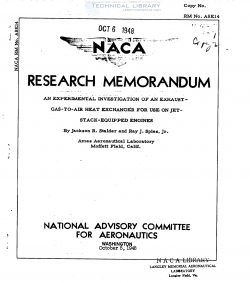naca-rm-a8e14
- Version
- 44 Downloads
- 612.89 KB File Size
- 1 File Count
- April 20, 2017 Create Date
- April 20, 2017 Last Updated
National Advisory Committee for Aeronautics, Research Memorandum - An Experimental Investigation of an Exhaust-Gas-to-Air Heat Exchanger for Use on Jet Stack Equipped Engines

As part of a general investigation of thermal ice—prevention
systems, testd have been conducted of an exhaust—gas—to—air heat
exchanger designed for use in aircraft incorporating individual—
cylinder exhaust stacks. The thermal performance of the heat
exchanger was determined as well as the effect of the heat—exchanger
installation on indicated cylinder power and exhaust—Jet thrust.
The results of the tests indicate that predicted steady-flow
values of thermal output may be used with reasonable accuracy to
design intermittent—flow exhaust—gas heat—exchanger installations, _
provided that unrestricted exhaust stacks are used. A. reduction
of approximately 3 percent of total indicated cylinder power
resulted from. the increased exhaust—gas—flow resistance due to the
heat—exchanger installation. The loss in total head of the exhaust
gas during its passage through the heat exchanger caused a reduction
of exhaust—gas thrust of 15 percent at the highest Jet velocity
obtained. 'Ihe reduction was smaller for lower ,jet velocities.
During the course of a general investigation of ice—prevention
techniques conducted at the Ames Aeronautical Laboratory, it was
found (reference 1) that the most effective method of preventing
ice formations consisted of supplying heat to the affected portions
of the airplane structure. Consideration of various sources of heat
revealed that the engine exhaust gas was themost obvious and practi—
cal source for the large quantities of heat required to prevent
ice accretions on wings, empennage, and windshield. Use of the engine
exhaust gas as a heat source, however, involved the use of exhaust—
gas—to—air heat exchangers; consequently, a general research program
was initiated in order to determine the performance characteristics
of various types of heat exchangers suitable for installation in the
exhaust systems of reciprocating aircraft engines. Considerable
research (references 2, 3, and 14-) has been completed in applications
involving the use of a single heat exchanger located in an exhaust—
gas stream of practically constant velocity such as exists with
engines utilizing collector-ring—type exhaust systems. The present
research is an extension of the previous work to the case of unsteady
exhaust-gas flows, such as are encountered in reciprocating engines
having individual-cylinder exhaust stacks, since it would be expected
that the intermittent nature of the exhaust—gas flow in an individual—
cylinder exhaust stack might affect the thermal performance of a heat
exchanger.
| File | Action |
|---|---|
| naca-rm-a8e14 An Experimental Investigation of an Exhaust-Gas-to-Air Heat Exchanger for Use on Jet Stack Equipped Engines.pdf | Download |

Comment On This Post